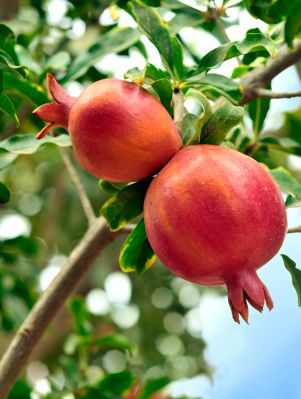Pomegranates

Pomegranates get a lot of attention as a “super-fruit,” lauded for their health benefits. Truthfully, pomegranates can do some “wonderful” (the name of a popular variety) things for your health; research has shown that they have antioxidant, antibacterial, anti-inflammatory, antiviral, and anti-carcinogenic properties. As an added bonus pomegranates (Punica granatum L.) have a fun appearance and a delicious flavor.
When you cut open a pomegranate you’ll find the fruit filled with arils, the edible part of the fruits. These arils are juice-filled orbs which also contain the pomegranate seeds. Pomegranate arils range from very sweet to tart/tangy depending on the variety. The juice is either consumed fresh or made into a syrup (grenadine), wine, sorbet, or jelly. Arils can also be enjoyed fresh on their own, added to salads, or worked into a variety of other dishes. Pomegranates are rich in antioxidants, thiamin, riboflavin, niacin, vitamins B6, B9, and C, calcium, iron, magnesium, phosphorus, potassium, and zinc!
The word “pomegranate” derives from Latin and means “seeded apple.” Native to Iran, Afghanistan, Pakistan, and the Himalayan region, pomegranates have a long history of cultivation. There were extensive cultivations in Spain which moved with the missionaries into Mexico and California in the 1500s. While pomegranates come from areas of the world that have drier summers than we have in Florida, these trees have been grown as a dooryard plants here for decades. Pomegranate plants have been discovered in the Panhandle that are 80 to 100 years old. The exact origin of these decades-old plants is unknown.
Characteristics
Pomegranates can be grown as an attractive deciduous shrub or as a tree in Florida landscapes. The shrubs are dense and bushy and will grow to between 6 and 12 feet tall. When trained to grow as a tree, your pomegranate may reach 20 feet tall.
Pomegranates have glossy, dark green leaves and slender thorny branches. Pomegranate flowers have crinkled petals and can range in color from pale pink to bright orange-red. The fruits have a smooth, leathery skin and are shaped like a slightly flattened sphere; they range in color from pinkish-yellow to purplish-red.
Pomegranates in North Florida mature from July to November, but may produce fruit year-round in South Florida. Some varieties are best for use as ornamentals while others are grown for eating. The University of Florida is collaborating with pomegranate growers in experimental trials to identify cultivars suited for Florida. The preliminary results show ‘Girkanets’, ‘Kazake’, ‘Wonderful’, ‘Al-sirin-nar’, and ‘Medovyi Vahsha’ varieties perform well. Additionally, ‘Christine’ and ‘Salavatski’ are popular home garden cultivars.
Planting and Care
For best growth and fruit production, pomegranates need deep, slightly acidic, moist soil. Plants need irrigating every 7 to 10 days when there isn’t significant rainfall. It’s important to maintain adequate soil moisture in late summer and early fall to reduce potential fruit splitting.
These plants naturally grow into a multi-trunk bushy shrub with many suckers growing in the root and crown area. If you prefer, you can encourage your plant to grow into a tree form by pruning off the suckers and allowing only one trunk to develop. It’s best to remove suckers from around the main trunks regularly. When you plant your tree, let it grow the first year without pruning. During the second year, select four to six strong sprouts that will make up the main structure of the tree. Remove any excessive branches and sprouts frequently during the growing season. During the first two years of growth prune your plant to produce stocky, compact framework.
Pomegranate trees are self-pollinating, which means you only need to plant one tree in order to get fruit. You tree will produce more fruit if it is planted in full sun rather than in a shady area.
Leaf blotch and fruit spot are the diseases often observed on Florida pomegranate trees. Leaf blotch will appear as small, circular to angular dark reddish-brown to black areas on the leaves. Infected leaves are pale green and fall prematurely. Fruit spot looks like small, conspicuous, dark brown spots that are initially circular and become angular. These diseases can be controlled with a fungicide (conventional or organic). Check the label to be sure it is approved for use on pomegranates and safe to use on edible fruits.
